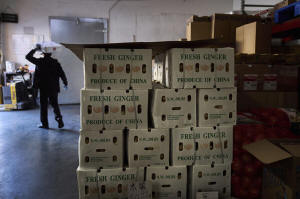As tariffs put trade between China and the US in peril, Chinese
businesses ponder the future
[April 14, 2025] By
HUIZHONG WU and DIDI TANG
When the first two rounds of 10% tariffs hit, Zou Guoqing, a Chinese
exporter, groaned but didn't find the barriers insurmountable. He gave
up some of his profits and offered his client, a snow-bike factory in
Nebraska, price cuts ranging from 5% to 10%. It seemed to work: The
factory agreed to a new order of molds and parts.
But when President Donald Trump announced an additional 34% universal
tariff on Chinese goods on April 2, Zou, who has been exporting to the
United States for more than a decade, was incredulous.
“There's not a thread of feasibility," said Zou, who does business in
the eastern Chinese city of Ningbo. “It looks like I would have no
choice but give up trading with the U.S.”
Then came 50% more from Trump, followed by another increase that pushed
the universal tariff on Chinese goods to 145%, and Zou said he now could
only hope that Trump and Chinese leader Xi Jinping can communicate. “We
are pausing the shipments," he said, “until the leaders talk.”
That U.S. tariff and the retaliatory 125% tariff from China are putting
businesses that trade between the U.S. and China on edge. They are
fretting not only about their next orders but also their viability if
there is no quick relief. Experts are worried the decades-long trade
ties that have underpinned the relationship between the world's two
largest economies could be unraveling.

Trade ties are tested
If the high tariff is sustained for the next six months or longer, “that
would actually lead to a real effective decoupling between the American
and Chinese economies,” said Chen Zhiwu, professor of finance at Hong
Kong University Business School.
Josh Lipsky, senior director of the Atlantic Council’s GeoEconomics
Center, said the tariff, if kept in place, amounts to “almost a trade
embargo,” making it impossible for China to export low-value items such
as apparel to the U.S. It also would force U.S. businesses to source
elsewhere, away from China, if there should be alternatives, he said.
The Trump administration late Friday said it would exclude electronics
such as smartphones and laptops from the reciprocal tariffs, which means
they won’t be subject to the 145% tariffs levied on China. The exemption
seemed to reflect Trump's realization that his China tariffs are
unlikely to shift more manufacturing of smartphones, computers and other
gadgets to the U.S. any time soon.
In China, the central tariff office declared there was “no possibility
for market acceptance" of U.S. goods exported to China at the current
tariff level.
“Everyone’s pretty worried,” said Hu Jianlong, founder of Brands
Factory, a consultancy that works with Chinese companies trying to break
into overseas markets. “At this point in time, there’s no good way
forward. This situation has not resolved ... there's no final number.
And so everyone’s still waiting to see how this will develop.”
The tariff war has come more than 20 years after China, with the help of
the United States, joined the World Trade Organization and began to see
its economy soar on luring foreign investments and exporting to the U.S.
and other Western markets. By last year, China-U.S. trade was $582
billion, but tensions have flared over China's widening trade imbalance
with the U.S. That led to the first tariff skirmish during the first
Trump term.

The trade deficit has since narrowed but stayed stubbornly high, at a
time when the U.S. and other Western markets have also grown concerned
about another onslaught of Chinese products such as electric vehicles.
Decouple or ‘de-risk’?
During his term, Democratic President Joe Biden stressed that the U.S.
was not trying to decouple from China but to “de-risk." He took the
“small-yard, high-fence” approach, under which his administration put up
barriers in targeted sectors such as advanced chips, artificial
intelligence and quantum computing that have national security
implications.
Now, Trump is declaring universal tariffs on Chinese goods but has said
he's also willing to talk with Beijing. It remains unclear what the
Republican president's goals might be.
[to top of second column] |

Boxes of ginger from China are stacked at a grocery market in the
Chinatown neighborhood of Los Angeles, Friday, April 11, 2025. (AP
Photo/Jae C. Hong)
 “What are they looking for in those
negotiations? How much is it possible to reduce these tariffs? What
are the other demands apart from China removing its retaliatory
tariffs that the United States wants to put forward. We don't know
what that would be,” said Greta Peisch, who served as the general
counsel for the Office of the U.S. Trade Representative in
2021-2024.
The message from China's leadership is loud and
clear. It will talk only when the U.S. stops “maximum pressure and
capricious and destructive behavior," said Lin Jian, a Chinese
Foreign Ministry spokesperson.
Li Cheng, professor of political science at the University of Hong
Kong, said the Chinese leadership is upset over being singled out by
Trump when the U.S. president paused reciprocal tariffs for 90 days
for all other countries. Beijing wants to make sure that “Donald
Trump not state one thing in the morning and say other things in the
evening," Li said, and that Trump's policies on China are not
hijacked by his anti-China, hawkish advisers.
With no leadership-level negotiations in the immediate future,
businesses are exploring their options.
Lisa Li, who works in sales for an athletic wear manufacturer in the
northern Chinese province of Hebei, said her business was
negotiating with clients over whether they could split the increased
costs. It's too early to say if her company is to give up on the
U.S. market, she said, but it will “definitely expand other avenues
for sales,” such as in Australia or Europe.
Differing views, but optimism is sagging
In the eastern Chinese city of Wenzhou, a manufacturing hub, a
holiday lights maker was less optimistic. Bo, who shared only his
surname out of concern for retaliation, said he could “only give up”
if the tariff hikes were here to stay because other markets might
not work.
“In the past few years, the European market has been in a slump,” Bo
said. “So we had wanted to try and develop our business in the
United States.”

In Hong Kong, Danny Lau, who runs an aluminum-coating factory in the
nearby southern Chinese city of Dongguan, said one of his U.S
clients would keep buying from him for an ongoing project but was
unsure about the next project. Another client told Lau that the
chances are slim to strike a deal when tariffs are so high. Lau has
been exploring other markets, but he says it's not easy because some
may find his high-quality products too expensive.
At a port in the Chinese city of Shanghai, ships heading to the U.S.
had almost vanished by Thursday, the day after Trump's tariff on
China took effect, according to a report by the financial news site
Caixin. Major shipping lines were drastically cutting back on
trans-Pacific routes, the report said.
For the longer term, the tariff war is likely to prompt Chinese
businesses to diversify their supply chains and move part of their
manufacturing capacity outside of China, and even to the United
States, said Hu, the consultant.
Some might follow in the footsteps of the Tianjin steelmaking
business, which gave up trading with the U.S. after both Trump and
Biden raised tariffs on Chinese steel. “The best plan is to not come
into contact,” said David Yu, who works in the company's foreign
sales department.
However, not everyone is ready to give up on the U.S. market. Zou,
the exporter in Ningbo, describes the U.S. market as “reliable and
without finicky demands.”
“It's the best market on Earth,” he said. "I am waiting for the
rainbow after the storm.”
___
Wu reported from Bangkok and Tang from Washington. Associated Press
researcher Shihuan Chen in Beijing and writer Kanis Leung in Hong
Kong contributed to this report.
All contents © copyright 2025 Associated Press. All rights reserved |